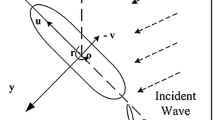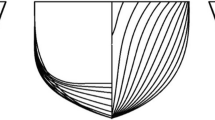Abstract
In this paper, we provide new experimental data of the wave-induced steady forces (the added resistance, wave-induced steady lateral force, and yaw moment) acting on a full hull ship in regular waves, and we verify the validity of existing prediction methods for wave-induced steady forces by performing comparisons with results obtained experimentally. For the prediction methods, we consider the zero-speed three-dimensional panel method (3DPM) and the method based on formulas of the wave-induced steady forces that are expressed using the Kochin-function assuming a slender ship (strip theory-based Kochin-function method: SKFM). The results show that the calculation accuracy obtained using 3DPM and SKFM for added resistance and steady lateral force is acceptable for practical purposes although the accuracy is insufficient for the steady yaw moment. In order to confirm the applicability of both methods to the problem of maneuvering in waves, we predict the turning motions of the ship in irregular waves using the calculation results obtained by 3DPM and SKFM for the wave-induced steady forces, and we compare the turning motions with the free-running model test results. Both methods are useful for predicting turning motions in irregular waves.














Similar content being viewed by others
References
Takahashi T (1988) A practical prediction method of added resistance of a ship in waves and the direction of its application to hull form design. Trans West-Japan Soc Naval Archit 75:75–95 (in Japanese)
Tsujimoto M, Kuroda M, Sogihara N (2013) Development of a calculation method for fuel consumption of ships in actual seas with performance evaluation. ASME, 32nd International Conference on Ocean, pp 1–10
Naito S, Mizoguchi S, Kagawa K (1991) Steady forces acting on ships with advance velocity in oblique waves. J Kansai Soc Naval Archit 213:45–50 (in Japanese)
Iwashita H, Ito A, Okada T, Ohkusu M, Mizoguchi S (1992) Wave forces acting on a blunt ship with forward speed in oblique sea. J Soc Naval Archit Japan 171:109–123 (in Japanese)
Ueno M, Nimura T, Miyazaki H, Nonaka K, Haraguchi T (2001) Model experiment on steady wave forces and moment acting on a ship at rest. J Kansai Soc Naval Archit 235:69–77 (in Japanese)
Ueno M, Nimura T, Miyazaki H, Nonaka K (2000) Steady wave forces and moment acting on ships in manoeuvring motion in short waves. J Soc Naval Archit Japan 188:163–172 (in Japanese)
Yasukawa H, Adnan FA (2006) Experimental study on wave-induced motions and steady drift forces of an obliquely moving ship. J Japan Soc Naval Archit Ocean Eng 3:133–138 (in Japanese)
Kashiwagi M et al (2003) Hydrodynamics of floating bodies, Seizan-Do Shoten. ISBN4-425-71321-4 (in Japanese)
Maruo H (1960) Wave resistance of a ship in regular head seas. Bull Fac Eng Yokohama Natl Univ 9:73–91
Kashiwagi M (1991) Calculation formulas for the wave-induced steady horizontal force and yaw moment on a ship with forward speed . Reports of RIAM, Kyushu University, vol 37(107), pp 1–18
Watanabe I, Toki N, Ito A (1994) Chapter 2 strip method, theory of seakeeping performance and its application to ship design, 11th Marine Dynamic Symposium, The Society of Naval Architects of Japan, pp 167–187 (in Japanese)
Hamamoto M, Kim Y-S (1993) A new coordinate system and the equations describing manoeuvring motion of a ship in waves. J Soc Naval Archit Japan 173:209–220 (in Japanese)
Yasukawa H, Sano M, Hirata N, Yonemasu I, Kayama Y, Hashizume Y (2015) Maneuverability of \(C_b\)-series full hull ships (1st report: tank tests). J Japan Soc Naval Archit Ocean Eng 21:11–22 (in Japanese)
Kashiwagi M (1992) Wave-induced steady sway force and yaw moment on an advancing ship. Ship Technol Res 39(1):3–16
Kashiwagi M, Ohkusu M (1993) Study on the wave-induced steady force and moment. J Soc Naval Archit Japan 173:185–194 (in Japanese)
Faltinsen OM, Minsaas KJ, Liapis N, Skjordal SO (1980) Prediction of resistance and propulsion of a ship in a seaway, Proceeding of 13th Symposium on Naval Hydrodynamics, Tokyo, Japan, pp 505–529
Lewandowski EM (2003) The dynamics of marine craft: maneuvering and seakeeping, World Scientific Publishing Co. Inc., Singapore. ISBN-10: 9810247560
Yasukawa H, Hirata N, Yonemasu I, Terada D, Matsuda A (2015) Maneuvering simulation of a KVLCC2 tanker in irregular waves, International Conference on Marine Simulation and Ship Maneuverability (MARSIM’15), Newcastle, USB-memory
Yasukawa H, Yoshimura Y (2015) Introduction of MMG standard method for ship maneuvering predictions. J Mar Sci Technol 20:37–52
Acknowledgements
This study was supported by JSPS KAKENHI Grant No. JP26249135, and a part of this study was conducted as a collaborative research with Class NK (No. 14-29). We would like to thank Dr. A. Matsuda and Mr. M. Shirai for their assistance with the free-running model tests.
Author information
Authors and Affiliations
Corresponding author
A comparison of added resistance in head waves for other ships
A comparison of added resistance in head waves for other ships
We compared the calculation results of added resistance coefficients in regular head waves by SKFM with the test results conducted in Hiroshima University Towing Tank (length: 100 m, width: 8 m, water depth: 3.5 m). The object ships are a VLCC called KVLCC2 and a container ship called KCS. Table 11 shows the principal particulars of the ship models used in the tank tests. The tests were performed with changing the ship speeds. Figure 15 shows the comparison of the added resistance coefficients for KVLCC2 and KCS. In the cases that the ship speed is relatively small (strictly speaking, \(\tau (\equiv U\omega _{e}/g)\) is smaller than 1/4), the scattering and radiation waves propagate upstream. The wave components influence the wave-height measurement. This is the reason why the fluctuation becomes large in the added resistance results with relatively small speed cases. The calculation results by SKFM roughly agree with the tank test results.
About this article
Cite this article
Yasukawa, H., Hirata, N., Matsumoto, A. et al. Evaluations of wave-induced steady forces and turning motion of a full hull ship in waves. J Mar Sci Technol 24, 1–15 (2019). https://doi.org/10.1007/s00773-018-0537-3
Received:
Accepted:
Published:
Issue Date:
DOI: https://doi.org/10.1007/s00773-018-0537-3





